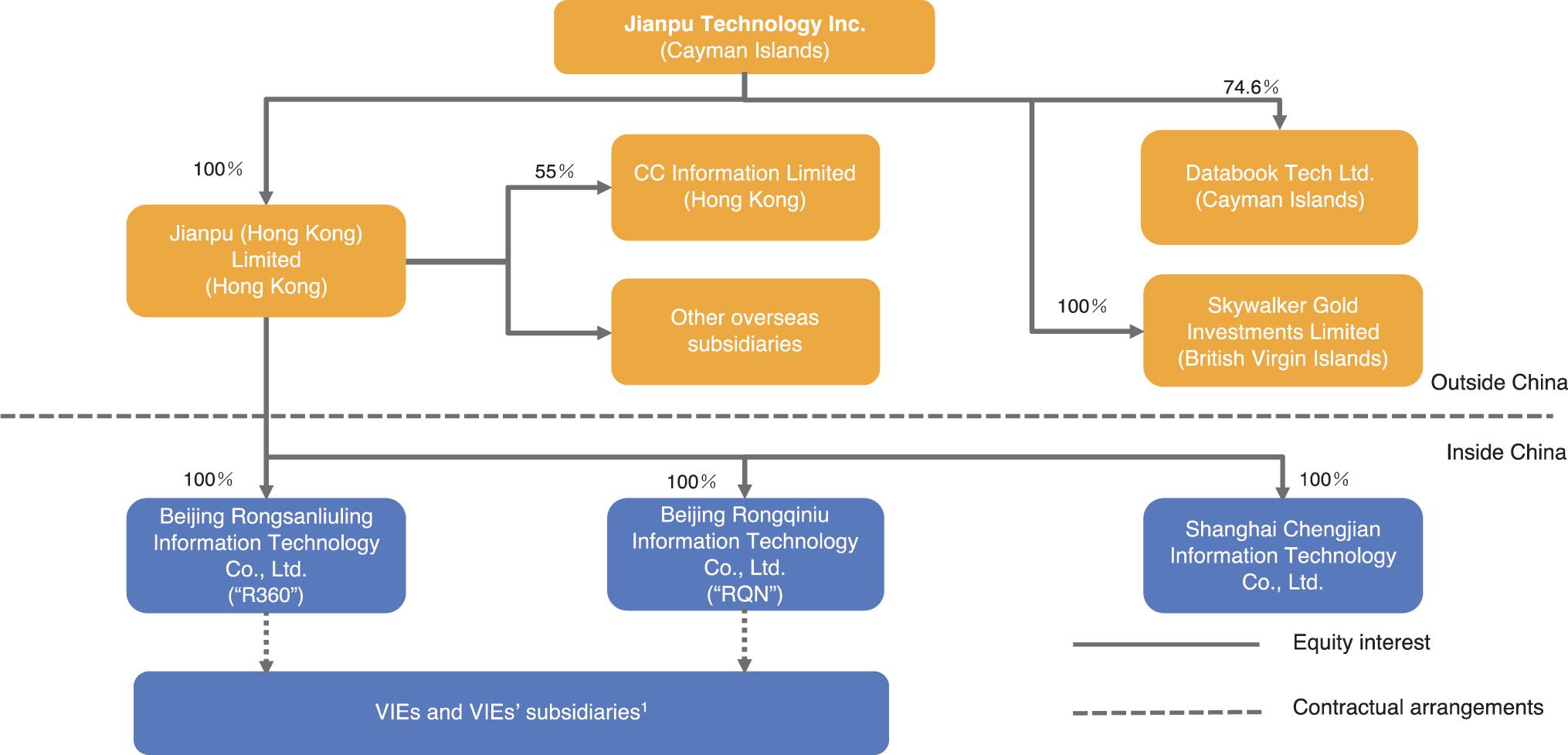The following diagram illustrates the principal entities in our corporate structure as of the date of this annual report:

Notes:
| (1) | Our VIEs include RDD, KTN, GKZX, HST and TCT. Shareholders of RDD and their respective shareholdings in RDD and relationship with our company are (i) Jiayan Lu (40%), our chief operating officer and co-founder; (ii) Huijing Ye (40%), family member of one of our co-founders; and (iii) Caofeng Liu (20%), our chief technology officer and co-founder. Shareholders of KTN and their respective shareholdings in KTN and relationship with our company are (i) Hui Li (60%), our employee; and (ii) Yang Liu (40%), our employee. Shareholders of GKZX and their respective shareholdings in GKZX and relationship with our company are (i) Xiang Zhu (60%), our employee; and (ii) Dan Huang (40%), our former employee. Shareholders of HST and their respective shareholdings in HST and relationship with our company are (i) Hangzhou Magic Ant Investment Management Partnership (limited partnership) (73.8%), an investment holding company controlled by the founder of Databook Tech Ltd. and its subsidiaries and VIE, collectively referred to as Databook in this annual report; and (ii) Tingxin Lu (26.2%), family member of one of our co-founders. Shareholders of TCT and their respective shareholdings in TCT and relationship with our company are (i) Xiaoqing Hu (51%), our employee; and (ii) Yuexuan Gao (49%), our employee. Our VIEs’ subsidiaries include RDD's subsidiary, Shanghai Anguo Insurance Brokerage Co., Ltd. Our contractual arrangements with HST and its shareholders are entered into through our wholly-owned subsidiary, Hangzhou Magnet Technology Co., Ltd. |
We have entered into a series of contractual arrangements, including exclusive purchase option agreements, equity pledge agreements, powers of attorneys and exclusive business cooperation agreements, with our VIEs and their shareholders. In particular, through the exclusive purchase option agreements, the shareholders of our VIEs irrevocably grant our PRC subsidiaries exclusive options to purchase all or part of the shareholders’ equity interests in the VIEs and all or part of the assets of the VIEs to the extent permitted under PRC law. Through the equity pledge agreements, the shareholders of our VIEs pledge all of their equity interests in the VIEs to guarantee their and the VIEs’ performance of their obligations under the contractual arrangements. Pursuant to the powers of attorneys, the shareholders of our VIEs appoint our PRC subsidiaries as their attorneys-in-fact to exercise all shareholder rights in our VIEs. Through the exclusive business cooperation agreements, our PRC subsidiaries have the exclusive right to provide the VIEs with technical, consulting and other services needed for the business of the VIEs and are entitled to receive a service fee from the VIEs in return. These contractual arrangements allow us to exercise effective control over our VIEs, receive substantially all of the economic benefits of our VIEs, and have an exclusive option to purchase all or part of the equity interests in our VIEs when and to the extent permitted by PRC law. As a result of these contractual arrangements, we are regarded as the primary beneficiary of our VIEs, and we treat them as our variable interest entities under U.S. GAAP. We consolidate the financial results of our VIEs and their subsidiaries in our consolidated financial statements in accordance with U.S. GAAP. For more details, see “Item 3. Key Information—D. Risk Factors—Risks Related to Our Corporate Structure— The shareholders of the VIEs may have potential conflicts of interest with us, which may materially and adversely affect our business and financial condition.” and “Item 4 Information on the Company—C. Organizational Structure—Contractual Arrangements with Our VIEs.”
7
 ” under category 36 and mobile apps, and we agreed not to raise any objection or bring any challenge against Qihoo Technology for its registration and use of the relevant 360 brand trademarks under category 36 and consent to the permanent coexistence of such trademarks with ours. There can be no assurance that we will successfully prevail or defend ourselves or reach a settlement to our satisfactory in other similar lawsuits or disputes in the future. In addition, as our business develops and expands, we may need to register other trademarks or intellectual property rights. If these trademarks or other intellectual property rights could not be registered, we may fail to prevent others from using these marks or other intellectual property rights, and our business, financial condition and results of operations may be materially and adversely affected. Furthermore, because of the rapid pace of technological change in our industry, parts of our business rely on technologies developed or licensed by third parties, and we may not be able to obtain or continue to obtain licenses and technologies from these third parties on reasonable terms, or at all.
” under category 36 and mobile apps, and we agreed not to raise any objection or bring any challenge against Qihoo Technology for its registration and use of the relevant 360 brand trademarks under category 36 and consent to the permanent coexistence of such trademarks with ours. There can be no assurance that we will successfully prevail or defend ourselves or reach a settlement to our satisfactory in other similar lawsuits or disputes in the future. In addition, as our business develops and expands, we may need to register other trademarks or intellectual property rights. If these trademarks or other intellectual property rights could not be registered, we may fail to prevent others from using these marks or other intellectual property rights, and our business, financial condition and results of operations may be materially and adversely affected. Furthermore, because of the rapid pace of technological change in our industry, parts of our business rely on technologies developed or licensed by third parties, and we may not be able to obtain or continue to obtain licenses and technologies from these third parties on reasonable terms, or at all.